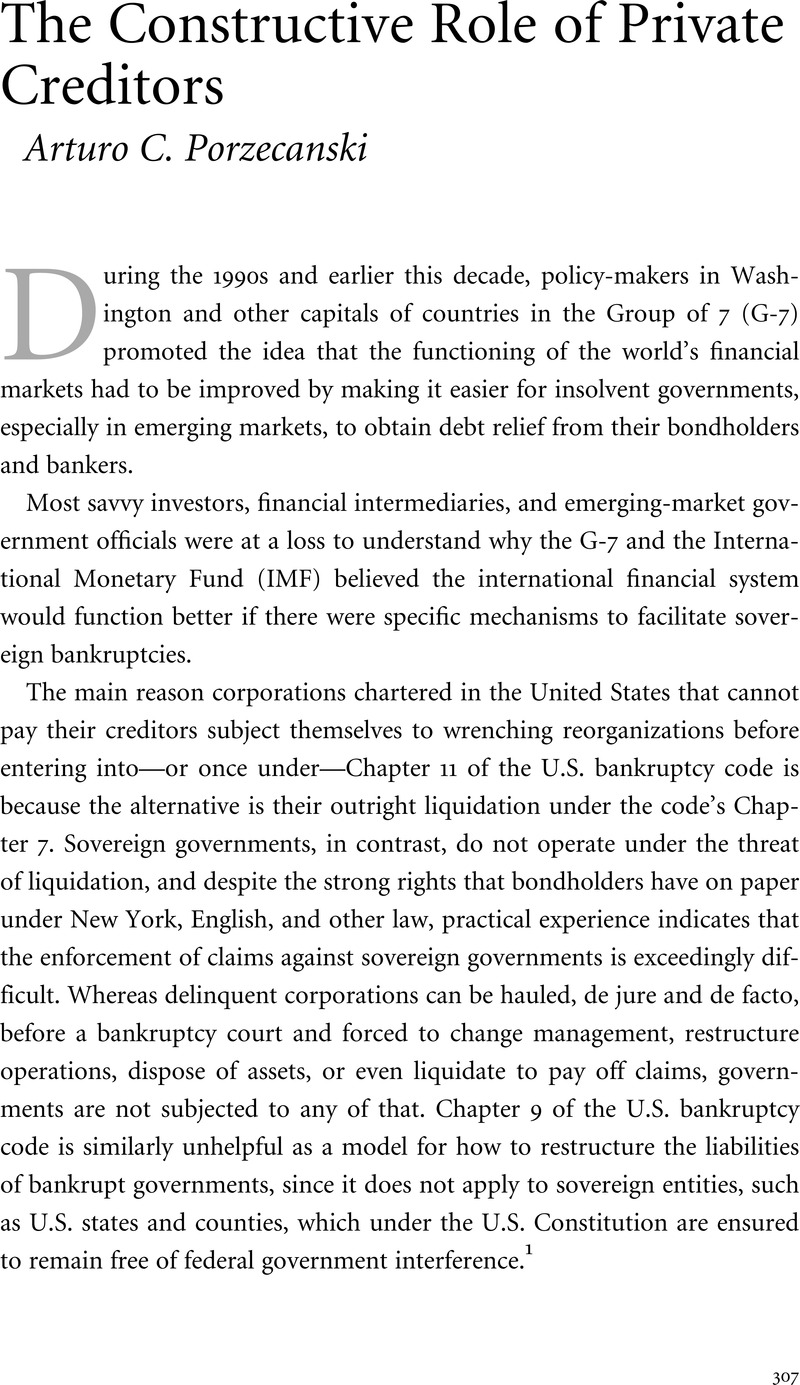No CrossRef data available.
Article contents
The Constructive Role of Private Creditors
Published online by Cambridge University Press: 25 March 2011
Abstract

- Type
- Part IV: International Policy Reforms
- Information
- Ethics & International Affairs , Volume 21 , Issue S1: Dealing Fairly with Developing Country Debt , November 2007 , pp. 307 - 319
- Copyright
- Copyright © Carnegie Council for Ethics in International Affairs 2007
References
Notes
1 Chapter 9 applies to nonsovereign entities such as municipalities, school districts, and publicly owned utilities. For a discussion of why Chapter 9 provides little guidance in the case of sovereigns, see Michelle J. White, “Sovereigns in Distress: Do They Need Bankruptcy?” Brookings Papers on Economic Activity 1 (2002), pp. 287–319.
2 See, e.g., Institute of International Finance, “Principles for Stable Capital Flows and Fair Debt Restructuring in Emerging Markets” (Washington, D.C.: Institute of International Finance, March 31, 2005), available at http:\\www.iif.com/emp/principles/.
3 Nor, of course, have they even mentioned the idea of subjecting troubled debtor governments to outside intervention of the type that New York City, for example, had to accept when it could not pay its bills in the early 1970s.
4 According to the then first deputy managing director of the IMF, a new approach to sovereign debt restructuring was needed because “in the current environment, it may be particularly difficult to secure high participation from creditors as a group, as individual creditors may consider that their best interests would be served by trying to free ride . . . . These difficulties may be amplified by the prevalence of complex financial instruments . . . which in some cases may provide investors with incentives to hold out . . . rather than participating in a restructuring.” See Anne O. Krueger, A New Approach to Sovereign Debt Restructuring(Washington, D.C.: International Monetary Fund, April 2002), p. 8 (emphasis added).
5 For useful background information on sovereign debt defaults and restructurings, see World Bank, Global Development Finance 2006: The Development Potential of Surging Capital Flows, vol. 1 (Washington, D.C.: World Bank, 2006), pp. 43–104.
6 See the TV interview with President Jorge Batlle of Uruguay, “El Default Significaba el Quiebre Institucional de Uruguay, ” July 4, 2003, available at http:\\www.presidencia.gub.uy/noticias/archivo/2003/julio/2003070404.htm. This version of events had previously been revealed by Vice President Luis Hierro of Uruguay, but had been denied by the IMF's spokesman; see IMF, “Transcript of a Press Briefing by Thomas C. Dawson, ” June 26, 2003, available at http:\\www.imf.org/external/np/tr/2003/tr030626.htm.
7 See IDA and IMF, “Heavily Indebted Poor Countries Initiative (HIPC) and Multilateral Debt Relief Initiative (MDRI): Status of Implementation, ” Washington, D.C., September 7, 2006, p. 66, available at siteresources.worldbank.org/DEVCOMMINT/Documentation/21046514/DC2006-0016(E)-HIPC.pdf.
8 See World Bank, Global Development Finance(Washington, D.C.: World Bank 2001), table 1.
9 See IMF and IDA, “Heavily Indebted Poor Countries Initiative (HIPC) and Multilateral Debt Relief Initiative (MDRI), ” p. 67.
10 See ibid., p. 25.
11 Other shorter maturity bonds were also issued, for example, to cover a portion of past-due interest, and Ecuador paid a small amount of arrears in cash.
12 See various Paris Club press releases relating to Ecuador available at http:\\www.clubdeparis.org/search_form?SearchableText=Ecuador.
13 See IMF, “Ecuador: First Review under the Stand-by Arrangement and Requests for Modifications and Waiver of Nonobservance and Applicability of Performance Criteria, ” IMF Country Report No. 03/248, August 2003, available at http:\\www.imf.org/external/pubs/ft/scr/2003/cr03248.pdf; and IMF, “Ecuador: 2005 Article IV Consultation, ” IMF Country Report No. 06/98, March 2006, available at http:\\www.imf.org/external/pubs/ft/scr/2006/cr0698.pdf.
14 See IMF, “Cross-Country Experience with Restructuring of Sovereign Debt and Restoring Debt Sustainability, ” August 29, 2006, pp. 12, 14, and 48–49, available at http:\\www.imf.org/external/np/pp/eng/2006/082906.pdf.
15 See IMF, “IMF Executive Board Concludes 2006 Article IV Consultation with Argentina, ” Public Information Notice No. 06/93, August 9, 2006, available at http:\\www.imf.org/external/np/sec/pn/2006/pn0693.htm.
16 In early 2007, Argentina reportedly offered the leading Paris Club governments to pay all outstanding principal and past-due interest over a relatively short period of ten years. See Clarín, “Club de París: la oferta argentina es pagar la deuda en 10 años y sin quita, ” January 14, 2007, available at http:\\www.clarin.com/diario/2007/01/14/elpais/p-01801.htm.
17 See IMF, “IMF Board Discusses the Good-Faith Criterion under the Fund Policy on Lending into Arrears to Private Creditors, ” Public Information Notice No. 02/107, September 24, 2002, available at http:\\www.imf.org/external/np/sec/pn/2002/pn02107.htm.
18 The U.S. government and the Federal Reserve also filed amicus briefs for Argentina in April 2006, in support of a U.S. court decision to vacate an order of attachment against certain funds belonging to the Central Bank of Argentina held at the Federal Reserve Bank of New York, which was then on appeal.
19 See Arturo C. Porzecanski, “From Rogue Creditors to Rogue Debtors: Implications of Argentina's Default, ” Chicago Journal of International Law 6, no. 1 (2005), pp. 327–31.
20 See Group of Ten, “Report of the G-10 Working Group on Contractual Clauses, ” September 26, 2002, available at http:\\www.bis.org/publ/gten08.pdf.


